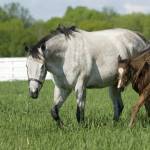Cool-Season Grasses and Fructans in Horse Diets

Many species of grasses have proven suitable for grazing by horses. Cool-season grasses seem especially appropriate for pastures, and because they do best in temperatures between 65 and 80 F (18 and 270 C), these grasses grow most abundantly in spring and fall. Growth slows in the warmer summer months in some years, and this is often referred to as the “summer slump,” though reduction in growth seems dependent on other factors, such as rainfall.
Five common species of cool-season grasses used in horse operations include timothy, orchardgrass, tall fescue, Kentucky bluegrass, and perennial ryegrass.
Timothy. Though timothy is a traditional grass species associated with horse diets and is easy to establish in horse pastures, it does not tolerate close grazing, and production wanes in late summer and early autumn. Timothy is a useful species in cool, wet conditions and produces leafy forage midseason when other plants have puttered-out.
Orchardgrass. Criticized occasionally for its lack of palatability and clump nature, orchardgrass has benefits, including its tolerance of dry and shady growing conditions, more so than most other cool-season grasses. Additionally, orchardgrass grows well in mediocre soils that other grasses have difficulty gaining a foothold.
Tall fescue. Advantages to using tall fescue in a grazing situation are numerous: hardy, tolerant of drought and close grazing, forbearing of heavy hoof traffic, and especially resistant to pests and pathogens. A significant drawback, however, is the presence of an endophyte that produces alkaloids that negatively affect pregnant mares. Producers may choose to use an endophyte-free variety, though some of the aforementioned benefits might be downgraded.
Kentucky bluegrass. Resistance to severe drought and ability to grow in light, sandy soils are two key advantages to Kentucky bluegrass. Though palatability is typically high among horses of all ages, yield is sometimes low in midseason. Kentucky bluegrass stands often require more fertilization than usual for optimal growth from season to season.
Perennial ryegrass. Like tall fescue, the value of perennial ryegrass is multidimensional: quick establishment following seeding, high-yielding growth, rapid regrowth following overgrazing, and sky-high palatability. A significant downside involves its production of water-soluble carbohydrates, including fructan, so perennial ryegrass is inappropriate for laminitis-prone horses.
Overconsumption of fructans, which accumulate in cool-season grasses, can wreak havoc on the hindgut biome. Because fructans are resistant to digestion in the small intestine, they pass on to the hindgut, where they are fermented. Fermentation of fructans changes the pH of the hindgut which, in turn, destroys beneficial bacteria, sends endotoxins throughout the body by way of the bloodstream, and allows pathogens to take hold in the hindgut.
The effects of fructan consumption can be diminished through the use of a hindgut buffer, such as EquiShure, developed by Kentucky Equine Research. By keeping pH fairly constant, the hindgut remains healthy, complete with microorganism equilibrium, and horses do not display typical signs associated with overindulgence of fructan-rich pastures, including gas and loose manure, as well as low-grade colic or laminitis.








